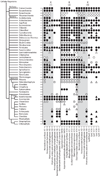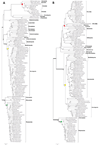Amino acids biosynthesis and nitrogen assimilation pathways: a great genomic deletion during eukaryotes evolution
- PMID: 22369087
- PMCID: PMC3287585
- DOI: 10.1186/1471-2164-12-S4-S2
Amino acids biosynthesis and nitrogen assimilation pathways: a great genomic deletion during eukaryotes evolution
Abstract
Background: Besides being building blocks for proteins, amino acids are also key metabolic intermediates in living cells. Surprisingly a variety of organisms are incapable of synthesizing some of them, thus named Essential Amino Acids (EAAs). How certain ancestral organisms successfully competed for survival after losing key genes involved in amino acids anabolism remains an open question. Comparative genomics searches on current protein databases including sequences from both complete and incomplete genomes among diverse taxonomic groups help us to understand amino acids auxotrophy distribution.
Results: Here, we applied a methodology based on clustering of homologous genes to seed sequences from autotrophic organisms Saccharomyces cerevisiae (yeast) and Arabidopsis thaliana (plant). Thus we depict evidences of presence/absence of EAA biosynthetic and nitrogen assimilation enzymes at phyla level. Results show broad loss of the phenotype of EAAs biosynthesis in several groups of eukaryotes, followed by multiple secondary gene losses. A subsequent inability for nitrogen assimilation is observed in derived metazoans.
Conclusions: A Great Deletion model is proposed here as a broad phenomenon generating the phenotype of amino acids essentiality followed, in metazoans, by organic nitrogen dependency. This phenomenon is probably associated to a relaxed selective pressure conferred by heterotrophy and, taking advantage of available homologous clustering tools, a complete and updated picture of it is provided.
Figures





References
Publication types
MeSH terms
Substances
LinkOut - more resources
Full Text Sources
Molecular Biology Databases

